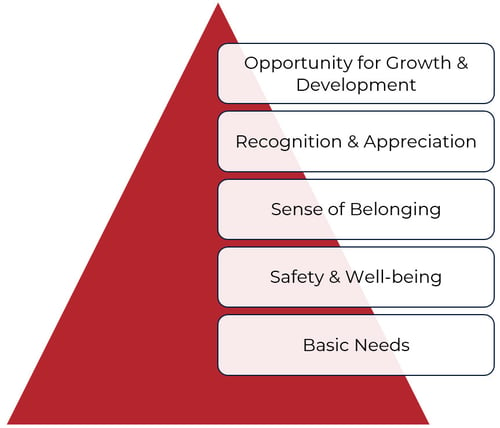Improving employee experience ranks as a top-five priority for HR professionals in 2021, according to a study by Gartner. An upstream focus, the topic has been linked to a number of pain points including low morale, high turnover rates, and declining customer satisfaction. In this article, we’ll explore five factors that directly impact employee experience in labor-dependent industries.
AEU LEAD’s Employee Experience Pyramid

Using Maslow’s hierarchy of needs as a foundation, the pyramid provides a sound reference point for companies wanting to improve the employee experience. Starting from the bottom, you must provide for lower-order listings before you can effectively address those higher in ranking.
Five Factors Influencing Employee Experience
The point of interface between employees and any organization is the frontline manager. Where team morale is an issue, there’s a strong likelihood it’s rooted in the relationship that exists between the workforce and supervision. Want proof? One of every two employees that voluntarily leave jobs do so to escape their boss. Simply put, improving the employee experience is contingent upon effective relations between supervisors and their direct reports. By focusing on the following areas, supervisors can greatly enhance those relations and improve the employee experience.
Basic Needs
When an employee gets to the jobsite, are they having to search for ladders, barricade materials, or welding leads? Are permits being authorized prior to the start of the shift? Are they able to get requests for information turned around in a timely manner? These are just a sampling of the things that frustrate employees. Making sure they’re ready to go when they arrive on the job and keeping needed materials available and readily accessible goes a long way in boosting morale. As a supervisor, you should know what matters most to your employees and what they need to maintain safe and productive operations. If you don’t, ask for their input.
Safety and Well-being
More and more companies are promoting a “safety-first” mantra. But do you walk the talk? If your employees internalize through experience that “safety is fine until you get behind”, you have some work to do. As humans, we have an essential need to feel safe. If the workplace doesn’t provide for that need, there’s little you can do to improve the employee experience that will matter. Make safety a priority and demonstrate it through your actions. If you do, you’ll be able to concentrate efforts on providing for a higher-order experience and enjoy the benefits of doing so.
Sense of Belonging
A well-organized and efficient jobsite whereby employees feel safe and productive is a byproduct of effective management and leadership practices. Creating a culture that fosters employee experience requires both qualities in a supervisor. With these lower-order needs in place, attention should be given to the next rung in the pyramid ranking.
A sense of belonging is important and created through interactions and discussions that take place informally on topics that don’t always involve business matters. Getting to know your employees and letting them get to know you, are far more important than we may have previously thought. This is especially true with our junior-most generations. Find common ground with direct reports and look for opportunities to discuss with them topics they find of interest. Making a personal connection is key to building rapport and helping employees feel as though they belong. Generally speaking, it only requires time, discipline, and effort to achieve.
Recognition & Appreciation
As previously stated, 50% of employees voluntarily leaving their jobs do so to escape their boss. Of those, approximately three of every four do so because they don’t feel valued or appreciated. If you want to impact the employee experience, you must find ways to recognize and show appreciation for a job well done. What’s more, it must be done in the moment and involve a genuine and authentic expression of gratitude. Anything less is not only meaningless; it can actually be counterproductive. Look for opportunities to recognize employees and take every advantage available to you to do so.
Opportunity for Growth & Development
Let’s face it, businesses of all sizes are flatter today than at any point in the past. An unfortunate consequence of lean organizations is fewer opportunities for advancement and promotion. That said, opportunities for growth and development have never been greater or more convenient.
By getting to know your employees on an individual basis, you are in a much better position to understand the personal interests of direct reports. While some may be perfectly content with perfecting their chosen craft, others need more. Allowing employees to cross-train, offering job planning opportunities, and routinely seeking input for matters impacting the workplace are all great ways to engage employees. Online learning, podcasts, and blogs are available to anyone and are great tools to provide ongoing development opportunities. Find out what’s important to your employees and help them connect with the resources needed to meet those needs. Doing so will help you earn respect and greatly enhance the employee experience.
Affecting Employee Experience
Employee experience has been recognized in recent years as an underlying cause for any number of operational pain points directly impacting the bottom line. As a human resource challenge and currently listed top-five priority for resolution, the topic will get more attention. Meaningful change, however, will only result from efforts to resolve the underlying factors that impact it most. More specifically, the relations that exist between the employee and his or her supervisor are undeniable and must be improved. Nothing has more impact on employee experience and few things will pay greater dividends.


